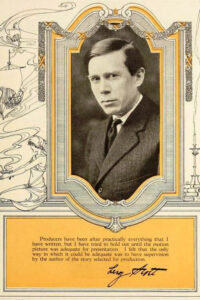
Children of the Whirlwind
It was an uninspiring bit of street: narrow, paved with cobble; hot and noisy in summer, reeking with unwholesome mud during the drizzling and snow-slimed months of winter. It looked like anything this May afternoon except a starting place for drama. But, then, the great dramas of life often avoid the splendid estates and trappings with which conventional romance would equip them, and have their beginnings in the unlikeliest environment; and thence sweep on to a noble, consuming tragedy, or a glorious unfolding of souls. Life is a composite of contradictions—a puzzle to the wisest of us: the lily lifting its graceful purity aloft may have its roots in a dunghill. Samson’s dead lion putrefying by a roadside is ever and again being found to be a storehouse of wild honey. We are too accustomed to the ordinary and the obvious to consider that beauty or worth may, after bitter travail, grow out of that which is ugly and unpromising.
Thus no one who looked on Maggie Carlisle and Larry Brainard at their beginnings, had even a guess what manner of persons were to develop from them or what their stories were to be.
The houses on the bit of street were all three-storied and all of a uniform, dingy, scaling redness. The house of the Duchess, on the left side as you came down the street toward the little Square that squatted beside the East River, differed from the others only in that three balls of tarnished gilt swung before it and unredeemed pledges emanated a weakly lure from behind its dirt-streaked windows, and also in that the personality of the Duchess gave the house something of a character of its own.
The street did business with her when pressed for funds, but it knew little definite about the Duchess except that she was shriveled and bent and almost wordless and was seemingly without emotions. But of course, there were rumors. She was so old and had been so long in the drab little street, that she was as much a legend as a real person. No one knew exactly how she had come by the name of “Duchess.” There were misty, unsupported stories that long, long ago she had been a shapely and royal figure in colored fleshings, and that her title had been given her in those her ruling days. Also, there was a vague story that she had come by the name through an old liking for the romances of that writer who put forth her, or his, or their, prolific extravagances under the exalted pseudonym of “The Duchess.” Also, there was a rumor that the title came from a former alleged habit of the Duchess of carrying beneath her shapeless dress a hoard of jewels worthy to be a duchy’s heirlooms.
Read or download Book
Leroy Scott
Leroy Scott (May 11, 1875 – July 21, 1929) was an American writer of novels and screenplays.
Biography
Scott was born in Fairmount, Indiana, on 11 May 1875. His father was a minister with the Religious Society of Friends. He graduated from Indiana University in 1897. His writing career began with three years of experience as a reporter; he worked at a Louisiana newspaper owned by his brother. Later (1900–01) he became assistant editor of the Woman’s Home Companion.
Scott was also a social activist. After gaining experience at the Hull House in Chicago, Scott served as assistant headworker at the University Settlement House in New York City in 1902–03. It was there that he met—and later married on 27 June 1904—Miriam Finn, a Russian Jewish writer. Around this same time, Scott was an officer of the Intercollegiate Socialist Society, of which he was a founder. After he departed from the University Settlement, Scott and his wife came to live in Greenwich Village at “A Club”, a writers’ cooperative housed in an old mansion on Fifth Avenue that became known as a “radical center.” They had one child, a daughter. In 1906, Scott helped arrange accommodations for Maxim Gorky during his visit to the United States. In 1907, Scott and his wife visited Russia. To research his book about labor relations, The Walking Delegate (1905), Scott joined the Structural Iron Workers Union. In addition to novels, Scott became involved in the movie industry, where he accumulated numerous writing credits, as well as an acting credit in one film. When Goldwyn Pictures determined a need to produce movies in New York as well as on the West Coast, Scott’s Partners of the Night was chosen as the first work. Scott drowned in Lake Chateaugay, near Plattsburgh, New York, on 21 July 1929.
Works
Children of the Whirlwind
The Walking Delegate (1905)
To Him that Hath (1907)
The Shears of Destiny (1910)
Vocations, ed. William DeWitt Hyde. Hall and Locke Company. Boston. Vol. 1. The Mechanic Arts. Richard C. Maclauren ed. (1911). “Selden’s Explosion Buggy”. p. 343
Counsel for the Defense (1912)
No. 13 Washington Square (1914)
Graft (1915)
Partners of the Night (1916)
The Sturdy Oak; a composite novel of American politics by fourteen American authors (ch xiv) (1917)
Mary Regan (1918)
A Daughter of Two Worlds: A Novel of New York Life (1919)
Cordelia the Magnificent (1923)
The Heart of Katie O” Doone (1925)
Folly’s Gold (1926)
The Trail of Glory (1926)
The Living Dead Man (1929)






